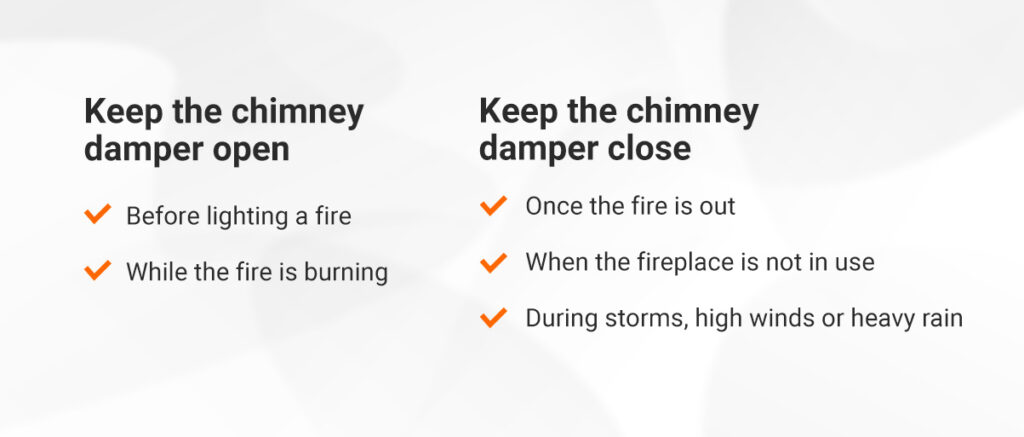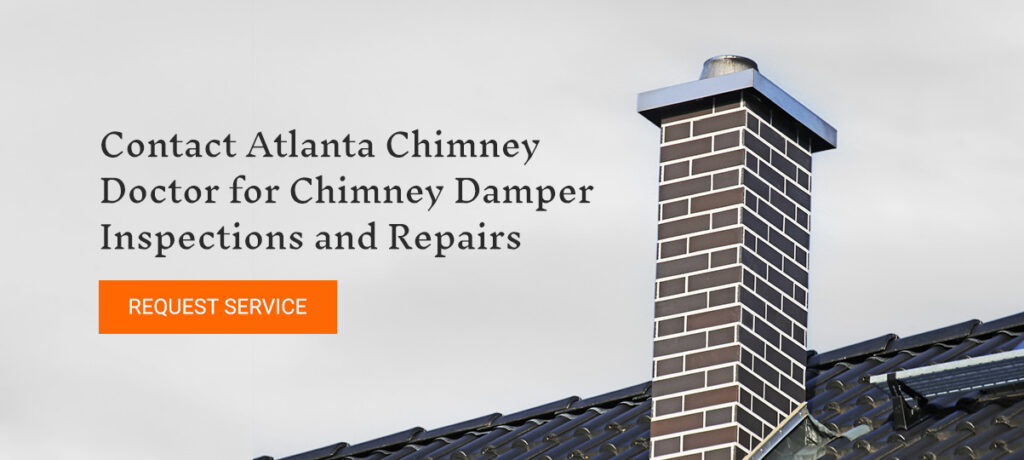A chimney damper is an important part of your chimney and fireplace. Many homeowners are unaware of what a damper does and how to determine if it works correctly. Understanding how to use a chimney damper and detect complications with it is important for maintaining a safe and efficient fireplace.
What Is a Chimney Damper?
A chimney damper lets the smoke out of a fireplace flue. This is an important aspect of your chimney during the winter when you use the fireplace and during summer when the fireplace is not in use. It is essential to understand when to use a chimney damper to ensure your fireplace operates as intended.
Without a chimney damper, the fumes and smoke from your fireplace will immediately fill your home and not exit through the chimney flue. The chimney damper plays an important role during the summer because atmospheric changes combined with air conditioning can cause hot outdoor air to enter your home through the chimney. The chimney damper prevents this warm air from entering your home and helps maintain energy efficiency.
Benefits of a Chimney Damper
Some of the most important benefits of chimney dampers include:
- Keep cold air out: Dampers help regulate the temperature within the house to improve your home’s overall energy efficiency. In winter, a chimney damper can help create a seal when you’re not using your fireplace to keep cold air out of your home. Without a damper, outside air can easily work its way down the chimney and enter your home, making your home’s heating system work harder.
- Prevent smoke from entering the home: Another important benefit of a chimney damper is it helps keep smoke away and prevents it from entering your home. Before starting a fire, you must open the damper so the smoke can naturally funnel through the chimney. Just as a damper can keep cold air from your home, it can also allow smoke to escape.
- Control fire intensity: Chimney dampers can also help control the overall intensity of your fire. You can adjust how long or strong your fire burns, as adjusting your damper can change the oxygen level available to the fire. This control allows you to influence the overall power and intensity directly.
- Ideal draft: A proper draft is an important aspect of any fire that allows the smoke to flow upward out of the chimney. A top-sealing damper can establish an ideal draft by sealing the top of the chimney, so opposing air drafts are not established down the chimney.
- Pest protection: Top-sealing dampers can also serve as a protective barrier from various pests. When a top-sealing damper is sealed, no pests can enter your chimney and take up residence. Many top-sealing dampers also feature a mesh-lined cap to protect against pests, even when the fireplace is in use.
Types of Chimney Dampers
There are two types of chimney dampers commonly seen in fireplaces — throat dampers and top-sealing dampers. The main difference between these dampers is where they are located. While both can improve the efficiency of your fireplace, each has unique benefits.
Chimney Throat Damper
A throat damper is one of the most common dampers found in older fireplaces. It is located directly above the fireplace opening and is typically made of steel, cast iron or stainless steel. A throat damper resembles a trap door as it has a flap that closes over a track and is usually controlled by something resembling a poker or a knot.
As a chimney throat damper closes, it forms a metal-to-metal seal. One important aspect of these dampers is that they may be more susceptible to rust and water damage, decreasing efficiency over time. Because a throat damper is positioned so close to the fireplace’s heat, it may eventually warp and no longer provide the necessary barrier required.
Top-Sealing Damper
A top-mount damper, or lock-top chimney damper, sits on top of the chimney instead of inside it, as a throat damper does. It is similar to a chimney cap, but it provides other benefits. When open, a top-sealing damper can help keep moisture, debris and animals out of the chimney. When closed, a top-sealing damper often creates a much tighter seal than a throat damper.
A chimney energy top damper contains a gasket, which can achieve a much tighter seal. The seal is connected to a stainless steel cable that goes down the chimney flue into the firebox and can be easily opened and shut. Because of this essential feature, a top-mount damper is much more energy-efficient and keeps moisture out of the chimney.
Keeping the flue warm is necessary to prevent cold air from leaking into other rooms. Top-mount dampers stop cold air from entering the source — the top of the chimney. Cold flues are also less likely to successfully move smoke out of your chimney when the fireplace is in use, which is another reason it’s in your best interest to keep your flue as warm as possible.
What Chimney Damper Do You Need?
Choosing the right chimney damper is crucial for improving fireplace efficiency, reducing energy costs and maintaining safety. Here’s how to know which damper to choose.

Functionality
The first step in choosing the right damper is considering how you use your fireplace. If you only light a fire occasionally, a throat damper may be all you need because it provides basic airflow control and prevents unwanted drafts.
However, a top-mount damper is the better option if you use your fireplace frequently or want to improve your home’s energy efficiency. Because it creates a tight seal at the top of the chimney, it prevents warm indoor air from escaping and stops cold air from entering your home when the fireplace isn’t in use. This reduces heating costs and helps keep your house cooler in the summer.
Ease of Use
You open and close throat dampers using a lever or knob located inside the firebox. These are straightforward to use but may require reaching into the fireplace, which can be inconvenient when dealing with soot buildup.
Top mount dampers are controlled by a cable or chain extending into the fireplace. This makes them much easier to use because you simply pull or release the chain to open and close the damper. If you want a more accessible and user-friendly option, choose top-mounted dampers.
Energy Efficiency
While effective at blocking drafts, a throat damper still allows some heat loss because of small gaps around the edges. This can lead to higher heating and cooling costs because warm air escapes in winter and outdoor air enters in summer. A top-mount chimney damper provides a near-perfect seal at the top of the chimney, preventing energy loss. This added insulation can help you cut down on heating and cooling exposes.
Installation
if your fireplace already has a throat damper, replacing it is generally straightforward because it involves swapping out the existing mechanism. However, if your throat damper is rusted, warped or broken, installing a top-mount damper may be the better long-term solution.
Top-mount dampers require installation at the chimney’s crown, which requires roof access. Some homeowners may opt for DIY installation, but it’s best to hire a fireplace and chimney expert for a secure fit.
Maintenance
Because throat damper materials are prone to rusting and warping, it can lead to difficulty opening and closing the damper. This may eventually require a full replacement. Top-mount dampers’ stainless steel and silicone seals make them more resistant to weather damage and less prone to rust. Because they sit at the chimney’s top, they also prevent rain, snow and debris from entering. This reduces the risk of moisture-related damage inside the chimney. A top-mount damper is the better choice if you’re looking for a low-maintenance and long-lasting solution.
When to Open and Close Your Damper
Knowing when to open and close your chimney damper is essential for fireplace safety and home comfort. The basic rule is to open the damper before starting a fire and close it once the fire is entirely out, but there are specific situations where opening or closing it at the right time can make a difference.
Keep the chimney damper open during these instances:

- Before lighting a fire: One of the most vital times to open your damper is before you start a fire. This allows smoke, gases and carbon monoxide to escape through the chimney instead of backing into your home.
- While the fire is burning: Once the fire is lit, the damper should stay open the entire time to keep the smoke and gases moving up and out of the chimney.
The best times to close your chimney damper include:
- Once the fire is out: The most common time to close your damper is after the fire has completely died out and the embers are cold to the touch. Closing it too soon may trap smoke and gases, while leaving it open unnecessarily can waste energy.
- When the fireplace is not in use: Even when you’re not actively using your fireplace, keeping the damper shut helps maintain energy efficiency and home comfort.
- During storms, high winds or heavy rain: If bad weather is expected, it’s best to keep your damper closed to prevent water, wind and debris from entering the chimney.
How Often Do Dampers Need to Be Replaced?
Routine chimney inspections and cleanings are important steps to ensure your fireplace and chimney can operate safely and efficiently. During a chimney inspection, a chimney sweep can evaluate the state of your chimney damper and detect an inadequate seal or rust. If your damper is not in ideal condition, you may need a chimney damper replacement.
Even if your throat damper is in good condition, you may want to consider replacing it with a top-sealing chimney damper to improve its overall efficiency. The overall life span of a chimney damper depends on numerous factors, including how often you use your fireplace and whether you keep up with necessary repairs.
Contact Atlanta Chimney Doctor for Chimney Damper Inspections and Repairs
Atlanta Chimney Doctor is a leading chimney inspection and repair provider dedicated to meeting and exceeding all our customers’ needs. Our owner is present at all jobs to ensure each customer receives the unique care and attention they deserve. We are a licensed and fully insured business offering various fireplace and chimney services.
We are members of the National Chimney Sweep Guild of America and the Atlanta Better Business Bureau. Additionally, all our chimney cleaners are certified by the Chimney Safety Institute of America. To learn more about our services or company, request a service online today.

